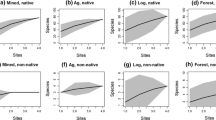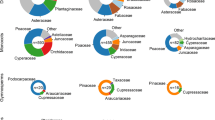Abstract
Observational studies of diversity have consistently found positive correlations between native and exotic species, suggesting that the same environmental factors that drive native species richness also drive exotic species richness, i.e., “the rich get richer”. We examined patterns of native and exotic plant species richness in temperate forests that have been undergoing reforestation since the turn of the twentieth century to test the influence of disturbance arising from land-use history on this relationship. Overall, we found no relationship between native and exotic plant species richness. Instead, we found a positive relationship between native and exotic richness in older but not younger-growth forests, suggesting that the same processes that drove exotic plant richness in older forests also facilitated native plants. In contrast, younger forests had similar numbers of native species relative to older forests, but 41% more exotic species and 24% more compacted soils. Moreover, exotic but not native species richness was positively correlated with increasing soil compaction across all sites. Overall, our results suggest that elevated exotic plant invasions in younger forests are a legacy of soil disturbance arising from agricultural practices at the turn of the century, and that native and exotic plants may respond differentially to disparate environmental drivers.






Similar content being viewed by others
References
Bassett IE, Simcock RC, Mitchell ND (2005) Consequences of soil compaction for seedling establishment: implications for natural regeneration and restoration. Austral Ecol 30:827–833
Brothers TS, Spingarn A (1992) Forest fragmentation and alien plant invasion of central Indiana old-growth forests. Conserv Biol 6:91–100
Burke MJW, Grime JP (1996) An experimental study of plant community invasibility. Ecology 77(3):776–790
Burke IC, Lauenroth WK, Coffin DP (1995) Soil organic matter recovery in semiarid grasslands—implications for the conservation reserve program. Ecol Appl 5(3):793–801
Case TJ (1990) Invasion resistance arises in strongly interacting species-rich model competition communities. Proc Natl Acad Sci U S A 87:9610–9614
Clarke KR (1993) Nonparametric multivariate analyses of changes in community structure. Aust J Ecol 18:117–143
Compton JE, Boone RD (2000) Long-term impacts of agriculture on soil carbon and nitrogen in New England forests. Ecology 81(8):2314–2330
Compton JE, Boone RD, Motzkin G, Foster DR (1998) Soil carbon and nitrogen in a pine-oak sand plain in central Massachusetts: role of vegetation and land-use history. Oecologia 116(4):536–542
Crow SE, Filley TR, McCormick M, Szlavecz K, Stott DE, Gamblin D, Conyers G (2009) Earthworms, stand age, and species composition interact to influence particulate organic matter chemistry during forest succession. Biogeochemistry 92(1–2):61–82
D’Antonio CM, Dudley TD, Mack M (1999) Disturbance and biological invasions: direct effects and feedbacks. In: Walker LR (ed) Ecosystems of the world 16: ecosystems of disturbed ground. Elsevier, New York, pp 413–452
Falkengren-Grerup U, ten Brink DJ, Brunet J (2006) Land use effects on soil N, P, C and pH persist over 40–80 years of forest growth on agricultural soils. Forest Ecol Manag 225(1–3):74–81
Flinn KM, Vellend M (2005) Recovery of forest plant communities in post-agricultural landscapes. Front Ecol Environ 3:243–250
Foster D, Swanson F, Aber J, Burke I, Brokaw N, Tilman D, Knapp A (2003) The importance of land-use legacies to ecology and conservation. Bioscience 53(1):77–88
Fridley JD, Brown RL, Bruno JE (2007) Null models of exotic invasions and scale-dependent patterns of native and exotic species richness. Ecology 85:3215–3222
Gilbert B, Lechowicz MJ (2005) Invasibility and abiotic gradients: the positive correlation between native and exotic plant diversity. Ecology 86(7):1848–1855
Greenwood KL, McKenzie BM (2001) Grazing effects on soil physical properties and the consequences for pastures: a review. Aust J Exp Agric 41(8):1231–1250
Gundale MJ, Jolly WM, Deluca TH (2005) Susceptibility of a northern hardwood forest to exotic earthworm invasion. Conserv Biol 19(4):1075–1083
Hale CM, Frelich LE, Reich PB, Pastor J (2005) Effects of European earthworm invasion on soil characteristics in northern hardwood forests of Minnesota, USA. Ecosystems 8(8):911–927
Hamza MA, Anderson WK (2004) Soil compaction in cropping systems: a review of the nature, causes and possible solutions. Soil Tillage Res 82(2):121–145
Higman D (1968) An ecologically annotated checklist of the vascular flora at the Chesapeake Bay Center for Field Biology, with keys. Office of Ecology, Smithsonian Institution, Washington DC
Hobbs RJ, Huenneke LF (1992) Disturbance, diversity, and invasion: implications for conservation. Conserv Biol 6:324–337
Huebner CD, Morin RS, Zurbriggen A, White RL, Moore A, Twardus D (2009) Patterns of exotic plant invasions in Pennsylvania’s Allegheny National Forest using intensive forest inventory and analysis plots. Forest Ecol Manag 257(1):258–270
Huxley A, Griffiths M (eds) (1999) The new Royal Horticultural Society dictionary of gardening. Nature Publishing Group, London
Jenkins MA, Parker GR (2001) Woody species composition of disturbed forests in intermittent stream bottomlands of southern Indiana. J Torrey Bot Soc 128(2):165–175
Kennedy TA, Naeem S, Howe KM, Knops JMH, Tilman D, Reich P (2002) Biodiversity as a barrier to ecological invasion. Nature 417:636–638
Knops JMH, Tilman D (2000) Dynamics of soil nitrogen and carbon accumulation for 61 years after agricultural abandonment. Ecology 81(1):88–98
Kulmatiski A, Beard KH, Stark JM (2006) Soil history as a primary control on plant invasion in abandoned agricultural fields. J Appl Ecol 43(5):868–876
Kyle GP, Beard KH, Kulmatiski A (2007) Reduced soil compaction enhances establishment of non-native plant species. Plant Ecol 193:223–232
Lemenih M, Karltun E, Olsson M (2005) Assessing soil chemical and physical property responses to deforestation and subsequent cultivation in smallholders farming system in Ethiopia. Agric Ecosyst Environ 105(1–2):373–386
Levine JM, D’Antonio CM (1999) Elton revisited: a review of evidence linking diversity and invasibility. Oikos 87:15–26
Lilley PL, Vellend M (2009) Negative native-exotic diversity relationship in oak savannas explained by human influence and climate. Oikos (in press)
Lundgren MR, Small CJ, Dreyer GD (2004) Influence of land use and site characteristics on invasive plant abundance in the Quinebaug highlands of Southern New England. Northeastern Nat 11(3):313–332
Maloney KO, Garten CT Jr, Ashwood TL (2008) Changes in soil properties following 55 years of secondary forest succession at Fort Benning, Georgia, U.S.A. Restor Ecol 16(3):503–510
Martin PH, Canham CD, Marks PL (2009) Why forests appear resistant to exotic plant invasions: intentional introductions, stand dynamics, and the role of shade tolerance. Front Ecol Environ 7(3):142–149
McCarthy BC, Small CJ, Rubino DL (2001) Composition, structure and dynamics of Dysart Woods, and old-growth mixed mesophytic forest of southeastern Ohio. Forest Ecol Manag 140(2–3):193–213
McDonald RI, Motzkin G, Foster DR (2008) Assessing the influence of historical factors, contemporary processes, and environmental conditions on the distribution of invasive species. J Torrey Bot Soc 135(2):260–271
McLauchlan K (2006) The nature and longevity of agricultural impacts on soil carbon and nutrients: a review. Ecosystems 9(8):1364–1382
Meiners SJ, Cadenasso ML, Pickett STA (2004) Beyond biodiversity: individualistic controls of invasion in a self-assembled community. Ecol Lett 7:121–126
Mosher ES, Silander JA, Latimer AM (2009) The role of land-use history in major invasions by woody plant species in the northeastern North American landscape. Biol Invasions. doi:10.1007/s10530-008-9418-8
Mountain WL (1989) Mile-a-minute (Polygonum perfoliatum L.) update-distribution, biology, and control suggestions. Pennsylvania Department of Agriculture. Weed Circ 15:21–24
Myster RW, Pickett STA (1990) Initial conditions, history and successional pathways in ten contrasting old fields. Am Midl Nat 124:231–238
Naeem S, Knops JMH, Tilman D, Howe KM, Kennedy T, Gale S (2000) Plant diversity increases resistance to invasion in the absence of covarying extrinsic factors. Oikos 91(1):97–108
Neill C, Von Holle B, Kleese K, Ivy KD, Colllins AR, Treat C, Dean M (2007) Historical influences on the vegetation and soils of the Martha’s Vineyard, Massachusetts coastal sandplain: implications for conservation and restoration. Biol Conserv 136:17–32
Oksanen J, Kindt R, Legendre P, O’Hara B, Simpson GL, Solymos P, Henry M, Stevens H, Wagner H (2008) vegan: community ecology package. R package version 1.15-1. http://cran.r-project.org/, http://vegan.r-forge.r-project.org/. Accessed 23 April 2009
Parks CG, Radosevich SR, Endress BA, Naylor BJ, Anzinger D, Rew LJ, Maxwell BD, Dwire KA (2005) Natural and land-use history of the Northwest mountain ecoregions (USA) in relation to patterns of plant invasions. Perspect Plant Ecol Evol Syst 7(3):137–158
Pierce JW (1974) Soil mineral analyses: % composition by mineral classes. In: Corell DL (ed) Environmental monitoring and baseline data. Smithsonian Institution Environmental Sciences Program, Temperate Studies, pp 1113–1129
Prosser CW, Sedivec KK, Barker WT (2000) Tracked vehicle effects on vegetation and soil characteristics. J Range Manag 53(6):666–670
R Development Core Team (2008) R: a language and environment for statistical computing. R Foundation for Statistical Computing, Vienna, Austria. ISBN 3-900051-07-0, http://www.R-project.org
Raper RL (2005) Agricultural traffic impacts on soil. J Terrramech 42:259–280
Standish RJ, Cramer VA, Hobbs RJ, Kobryn HT (2006) Legacy of land-use evident in soils of Western Australia’s wheatbelt. Plant Soil 280:189–207
Stohlgren TJ, Binkley D, Chong GW, Kalkhan MA, Schell LD, Bull KA, Otsuki Y, Newman G, Bashkin M, Son Y (1999) Exotic plant species invade hot spots of native plant diversity. Ecol Monogr 69(1):25–46
Stohlgren TJ, Barnett DT, Kartesz JT (2003) The rich get richer: patterns of plant invasions in the United States. Front Ecol Environ 1(1):11–14
U.S. Department of Agriculture, Forest Service (2002) Forest inventory and analysis national core field guide, volume 2: field data collection procedures for phase 3 plots, version 1.6. U.S. Department of Agriculture, Forest Service, Washington Office. Internal Report. On file with: U.S. Department of Agriculture, Forest Service, Forest Inventory and Analysis, Rosslyn Plaza, 1620 North Kent Street, Arlington, VA 22209
Winter K, Schmitt MR, Edwards GE (1982) Microstegium vimineum, a shade adapted C-4 grass. Plant Science Letters 24:311–318
Woitke M, Dietz H (2002) Shifts in dominance of native and invasive plants in experimental patches of vegetation. Perspect Plant Ecol Evol Syst 5(3):165–184
Acknowledgments
We thank E. Myron and C. Latimer for field assistance and two anonymous reviewers for constructive comments on the manuscript. This research was supported by NSF (DBI 0353759).
Author information
Authors and Affiliations
Corresponding author
Appendices
Appendix 1
See Table 1.
Appendix 2
See Fig. 7.
We found a significant, positive relationship between exotic species richness and native species richness at the 29 sites that have been continuously forested since at least 1952 but at not at the 21 sites that were fields in 1952. The relationships were qualitatively similar but marginally non-significant for 1974 and 1998 land use histories. Statistics are from linear regressions
Appendix 3
See Fig. 8.
We found significant, positive relationships between exotic species richness and native percentage cover across sites that had been continuously forested since at least 1938, 1952, 1974, and 1998. There were no relationships between native cover and exotic plant species richness at sites that were fields during each time period. Statistics are from linear regressions
Rights and permissions
About this article
Cite this article
Parker, J.D., Richie, L.J., Lind, E.M. et al. Land use history alters the relationship between native and exotic plants: the rich don’t always get richer. Biol Invasions 12, 1557–1571 (2010). https://doi.org/10.1007/s10530-009-9568-3
Received:
Accepted:
Published:
Issue Date:
DOI: https://doi.org/10.1007/s10530-009-9568-3






